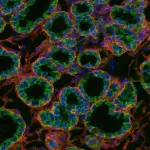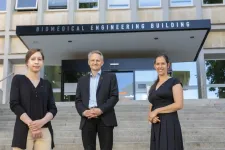(Press-News.org) Plastic waste is considered one of the biggest environmental problems of our time. IASS researchers surveyed consumers in Germany about their use of plastic packaging. Their research reveals that fundamental changes in infrastructures and lifestyles, as well as cultural and economic transformation processes, are needed to make zero-waste shopping the norm.
96 percent of the German population consider it important to reduce packaging waste. Nevertheless, the private end consumption of packaging in Germany has increased continuously since 2009. At 3.2 million tons in 2018, the amount of plastic packaging waste generated by end consumers in Germany has more than doubled since 1997. At 228 kilograms per capita, packaging consumption in Germany was significantly higher than the European average of 174 kilos per capita.
"Recycling only treats the symptoms of the plastic crisis and does not address the root cause, waste generation itself. We wanted to learn more about the barriers that prevent individuals in Germany from reducing their everyday consumption of plastic packaging for food and beverages. For our research project, a total of 40 participants contributed to discussions in four focus groups," explains Jasmin Wiefek, lead author of the study.
In their analysis of the discussions, the researchers identified twelve barriers to reducing plastic packaging consumption:
Habits: The focus group participants mainly shop at supermarkets or discounters rather than markets or zero-waste shops. The discussion also revealed that most participants do not take their own bags or containers when they go grocery shopping. Processed and packaged foods are popular.
Lack of knowledge: The researchers observed that participants were often uncertain which types of packaging are more sustainable than others.
Hygiene: Discussions revealed that participants held reservations about the hygienic properties of freely accessible displays of unpacked goods, the use of self-brought packaging and long-term reusable packaging options in general.
Material properties: Participants often preferred plastic packaging due to their material properties (e.g., lightweight, shatterproof, tear-resistant).
Priorities: Several participants described how their efforts to use less plastic packaging clashed with other priorities in their daily lives. One example given was that parents do not want to pack heavy backpacks for their children and accordingly prefer to use plastic instead of glass bottles.
Price: In general, groceries packaged in plastics are more affordable than plastic-free groceries.
Availability: By default, most groceries offered in supermarkets and discounters are only available in plastic packaging and so participants feel that they have little choice.
Diffusion of responsibility: According to the participants, both individuals and industry have a responsibility to solve the "plastic problem": On the one hand, because industry is responsible for the fact that so many products are packaged in plastic, it must offer solutions. However, they also emphasised that consumers should shop more consciously and avoid products in plastic packaging.
Reachability & infrastructure: Participants noted that places such as zero-waste shops or weekly markets were difficult to reach and required more time and effort to access than local supermarkets or discounters.
Time and time structures: Time is another crucial barrier to plastic-free shopping. Due to the travel distances involved, accessing zero-waste shops and markets would take up more time for most people. Participants pointed out that shopping would also take longer if they filled the food in their own containers and that the containers would have to be cleaned subsequently. They also noted that preparing unprocessed foodstuffs takes more time.
Convenience: Participants reported that they find it inconvenient to take their own containers to shops as it requires that they either carry the containers to work and back again or go out twice.
Consumer Culture: The participants stated that they did not attach much importance to the availability of a 'wide range of products' when shopping. However, many stressed the importance of reliably finding specific products in shops. This translates into an indirect demand for a wide range of products, which is difficult for zero-waste / low-plastic retailers to implement. Discussions in the focus groups also showed that our culture of spontaneous and on-the-go consumption makes it difficult to reduce packaging. Many participants were unaware that non-regional and non-seasonal foods, which we consume as a matter of course every day, must be packaged to maintain their freshness during long distance transport.
"Our results show that at present a lot of effort and knowledge is required for consumers to avoid plastic packaging. If we want to make low-waste goods and goods without single-use plastic packaging the cheapest and most convenient option, we will need to change the relevant infrastructures, economic incentives, and political framework conditions," explains project leader and co-author Katharina Beyerl. The goal of reducing the use of plastic packaging will not be achieved by merely asking consumers to shop exclusively in zero-waste stores. Instead, it requires fundamental changes in societal structures and lifestyles as well as a cultural shift.
INFORMATION:
Wiefek, J., Steinhorst, J., Beyerl, K. (2021 online): Personal and structural factors that influence individual plastic packaging consumption--Results from focus group discussions with German consumers. - Cleaner and responsible consumption, 3, 100022. https://doi.org/10.1016/j.clrc.2021.100022
One year after infection by SARS-CoV-2, most people maintain anti-Spike antibodies regardless of the severity of their symptoms, according to a study with healthcare workers co-led by the Barcelona Institute for Global Health (ISGlobal), the Catalan Health Institute (ICS) and the Jordi Gol Institute (IDIAP JG), with the collaboration of the Daniel Bravo Andreu Private Foundation. The results suggest that vaccine-generated immunity will also be long-lasting.
One of the key questions to better predict the pandemic's evolution is the duration of natural immunity. A growing number of studies suggest that most people generate a humoral ...
The eruption of the Laacher See volcano in the Eifel, a low mountain range in western Germany, is one of Central Europe's largest eruptions over the past 100,000 years. The eruption ejected around 20 cubic kilometers of tephra and the eruption column is believed to have reached at least 20 kilometers in height, comparable to the Pinatubo eruption in the Philippines in 1991. Technical advances in combination with tree remains buried in the course of the eruption now enabled an international research team to accurately date the event. Accordingly, the eruption of the Laacher See volcano occurred 13,077 years ago and thus 126 years earlier than previously assumed. This sheds new light on the climate history of the entire North ...
Scientists at the University of Helsinki have found an essential factor from the extracellular matrix that regulates functionality of the breast tissue for instance during pregnancy.
Extracellular matrix (ECM) has previously been recognised as an important element for the growth of various epithelial cells, but rather as a scaffold. A new study shows that ECM can also regulate the function of epithelial cells.
Our tissues constitute of differentiated cell types, which perform specific tasks that are tightly controlled. Normal growth and functioning of tissues is possible only when the various differentiated cell types interact appropriately. Differentiation and function of breast epithelium is guided by a group of cells responsive for estrogen and progesterone hormones. In the recent ...
Flat optics based on patterned liquid crystals (LCs) has recently received extensive research interest. Comparing with dielectric metasurfaces which are usually fabricated by sophisticated lithography process, LC polymer-based planar optics, owing to the self-assembly properties, can be fabricated through all-solution process. During the past decades, a variety of planar optical devices have been demonstrated based on geometric phase (also termed as Pancharatnum-Berry phase) manipulation. The total effective thickness of the device, including the underlying liquid crystal ...
Hitherto, the development of valvular heart disease in patients with chronic heart failure has been underestimated and rarely treated. This is the finding of a study conducted at the Division of Cardiology within the Department of Medicine II at Vienna General Hospital and MedUni Vienna and published in the prestigious British Medical Journal (BMJ). Mitral regurgitation was often previously interpreted as part of the progression of heart failure rather than a treatable disease in its own right.
Mitral regurgitation is a disease, in which the valve between the left atrium and left ventricle starts to leak, so that blood refluxes with ...
Computer models have been standard tools in basic biomedical research for many years. However, around 70 years after the first publication of an ion current model of a nerve cell by Hodgkin & Huxley in 1952, researchers at Graz University of Technology (TU Graz), in collaboration with the Medical University of Graz and the Memorial Sloan Kettering Cancer Center in New York, have finally succeeded in developing the world's first cancer cell model, thus launching "an essential tool for modern cancer research and drug development," reports a delighted Christian Baumgartner. The head of the Institute of Health Care Engineering with European Testing ...
Chronic fatigue syndrome / myalgic encephalomyelitis (CFS/ME) is a disabling disease, in which people have great difficulties in carrying out their daily activities. Despite its high prevalence, there are still no effective tools for its diagnosis, monitoring and treatment. To better understand and promote follow-up, as well as stratify fatigue in these patients, Vall d'Hebron, the Universitat Autònoma de Barcelona (UAB) and the Universitat Politècnica de Catalunya · BarcelonaTech (UPC) have developed a mobile application that could be useful in the assessment of the severity of fatigue in this syndrome, especially in women. The results of the study in which this technology has been tested have ...
Crystals have fascinated people through the ages. Who hasn't admired the complex patterns of a snowflake at some point, or the perfectly symmetrical surfaces of a rock crystal The magic doesn't stop even if one knows that all this results from a simple interplay of attraction and repulsion between atoms and electrons. A team of researchers led by Atac Imamoglu, professor at the Institute for Quantum Electronics at ETH Zurich, have now produced a very special crystal. Unlike normal crystals, it consists exclusively of electrons. In doing so, they have confirmed a theoretical prediction that was made almost ninety years ago and which has since been regarded as a kind of holy grail ...
When researchers at Lund University in Sweden performed advanced analyses of sputum from the airways of severely ill Covid-19 patients, they found high levels of neutrophil extracellular traps (NETs). It is already a known fact that NETs can contribute to sputum thickness, severe sepsis-like inflammation and thrombosis. After being treated with an already existing drug, the NETs were dissolved and patients improved. The study has now been published in Molecular & Cellular Proteomics.
Using advanced fluorescence microscopy, the researchers examined sputum in the airways of three severely ...
There might be fewer bonobos left in the wild than we thought. For the last 40 years, scientists have estimated the abundance of endangered bonobos by counting the numbers of sleeping nests left by the apes in forests of the Congo Basin. Now, researchers from the Max Planck Institute of Animal Behavior report that the rate of sleeping nest "decay" has lengthened by 17 days over the last 15 years as a result of declining rainfall in the Congo Basin. The study warns that longer nest decay times have serious implications for ape conservation: failure to account for these ...






